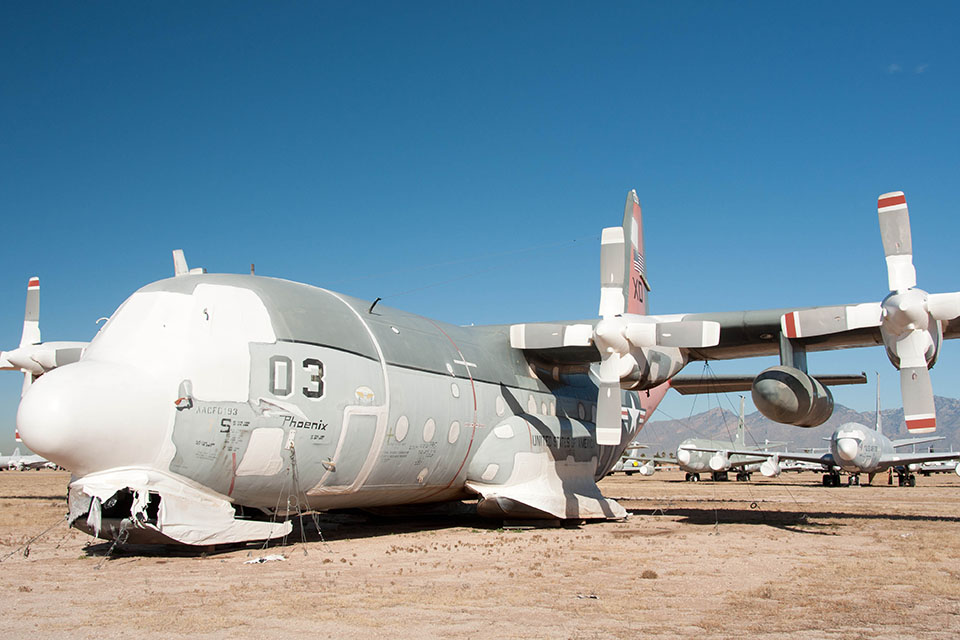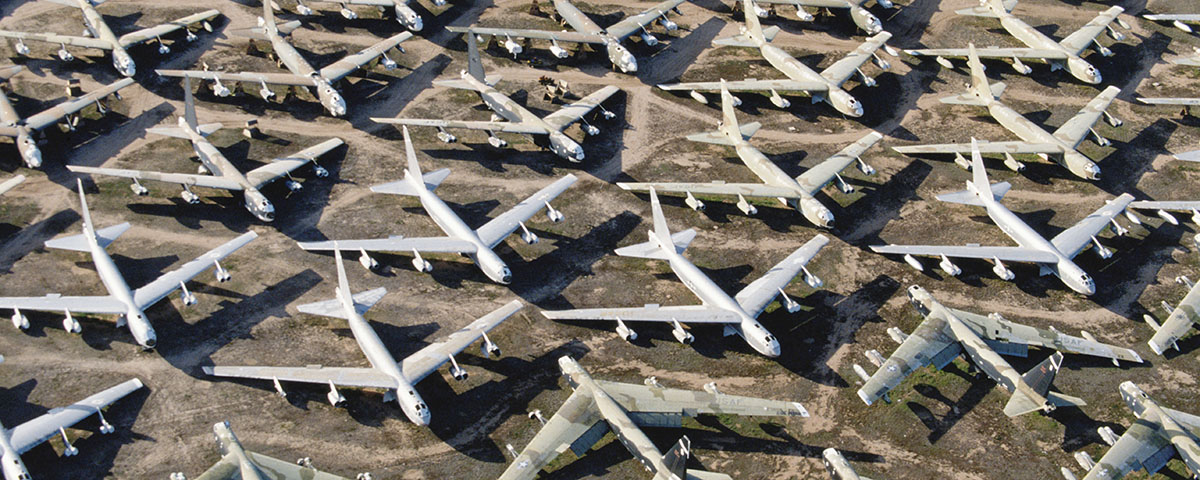Aged fighters, bombers and support aircraft—many of them decades old—stand in neat rows as far as the eye can see. Warm winds stir flapping pieces of canvas and whistle across loose antenna wires. Tufts of dried brown grass sprinkle the ground, and the occasional tumbleweed drifts past the long lines of silent sentinels. A long-eared jackrabbit springs off into the distance between the massive hulks of two B-52 bombers, an unlikely juxtaposition of nature and machines of war.
Walking among the 4,000-plus retired military aircraft at the 309th Aerospace Maintenance and Regeneration Group (AMARG) at Davis-Monthan Air Force Base, just south of Tucson, you understand why the facility has acquired its nickname “the Boneyard.” Your first thought, as you pass row upon row of warbirds arranged in precise herringbone patterns in Arizona’s sun-bleached Sonora Desert, is that it’s like a massive graveyard. But looks can be deceiving: Some of the aircraft here are not quite dead yet.
A tour of the AMARG Boneyard is an eerie, nostalgic journey through the pantheon of U.S. military aviation history. Almost every type of aircraft from the U.S. Air Force, Army, Coast Guard, Navy, Marine Corps—even NASA—has ended up here awaiting its fate. More than 100 conventional aircraft types share space with a few surprises, like former presidential helicopters, Century Series fighters and a D-21 drone for an SR-71 Blackbird. Toss in a couple of MiGs, some converted military commercial aircraft, the gondola from the Navy’s sole surviving post WWII airborne early-warning blimp and the odd Titan II missile reentry vehicle, and it’s clear why a visit to AMARG is a rite of passage for aviation enthusiasts.
The Boneyard had its genesis in 1946, when the U.S. military was looking for a place to store thousands of surplus WWII aircraft, primarily B-29s and C-47s. Davis-Monthan offered an ideal location because of its low humidity, sparse rainfall and high altitude, all of which minimize rust and corrosion. The hard alkaline topsoil, about 6 inches deep, with a clay-like sublayer called “caliche,” also provides an ideal platform for moving heavy aircraft around without having to pave large areas.
In 1965 Davis-Monthan AFB was designated the Military Aircraft Storage and Disposition Center (MASDC), where all surplus military aircraft were to be consolidated. After the withdrawal from Vietnam in the 1970s, the total number of aircraft stored here reached a staggering high of 6,080. In 1985 the facility was renamed the Aerospace Maintenance and Regeneration Center (AMARC), a reflection of the additional tasks it performs, including aircraft maintenance, refurbishing and reactivation. The facility also reclaims or cannibalizes parts, stores aircraft to be sold to foreign air forces, reconfigures airplanes as drone aerial targets, destroys and disposes of aircraft under various treaties and stores production tooling.
Most recently, in 2007 the facility was renamed the 309th AMARG, under the 309th Maintenance Wing at Hill AFB in Utah. Despite its military designation, of the 1,011 people working for AMARG, only two are active duty Air Force personnel. Many of the civilian employees are retired from military service.
Bus tours of the 2,600-acre facility leave from the nearby Pima Air & Space Museum, itself well worth a visit. The tour proceeds along “Celebrity Row,” a three-quarter-mile-long paved road where one model of each aircraft stored at AMARG stands on display. The ghost planes are lined up along both sides, with signs in front of each indicating its type. The stories of some of these aircraft are fascinating.
The Lockheed LC-130 Hercules Phoenix (tail no. 8321), for example, was embedded in ice in Antarctica for 17 years after working on Operation Deep Freeze for the National Science Foundation. The Hercules crashed following a mishap with its rocket-assisted takeoff system. The Navy declared the Herc a write-off, and it sank deep into the ice, until only its tail and propeller tips were visible. In 1988 it was dug out, repaired and flown for another 10 years before retiring to AMARG, still in top condition.

The F-14 (no. 159437) was one of two Tomcats from the carrier John F. Kennedy that shot down a pair of Libyan MiG-23 Floggers over the Gulf of Sidra on January 4, 1989, in a brief but exciting dogfight. The Floggers appeared to be heading straight for the Tomcats, despite the Americans’ maneuvers indicating they were not looking for trouble. When the Floggers continued on a hostile path, the Tomcats first loosed AIM-7 Sparrow missiles, which took out one of the MiGs, followed by an AIM-9 Sidewinder that torched the second MiG.
In 1979, C-141 Starlifter no. 40614 from the 53rd Military Airlift Squadron lost two engines immediately after takeoff from Richmond, Australia, en route to Alice Springs. A fire broke out in the cargo hold, filling the airplane with thick smoke. The pilot veered toward a nearby riverbed to avoid hitting the town of Richmond, but then managed to return to the airport. The Starlifter landed trailing engine parts and fuel, with all crewmen surviving unhurt.
What becomes of these aircraft? AMARG uses a four-tiered classification system that determines their fate. Type 1000 aircraft are here for long-term storage, to be maintained until recalled to active service, should the need arise. These aircraft are considered inviolate, meaning they have a high potential to return to flying status and no parts may be removed from them. They are “represerved” every four years. The Type 1000s include hundreds of F-16s that are scheduled to become remotely flown drone targets in the near future. Nearly 1,000 aircraft have been processed here for conversion into drones since 1976—mainly F-100 Super Sabers, F-102 Delta Daggers, F-106 Delta Darts and F-4 Phantoms.
The majority of the aircraft stored at AMARG are Type 2000s, used as a source of parts to keep other aircraft flying. In 2010, the 309th reclaimed 13,342 parts with an original value of $557.1 million. The crews pull the parts, then seal the aircraft back up.
Type 2000s are prepared for storage by draining the fuel and replacing it with lightweight oil, which is drawn through the engines by running them for a short time. The oil is then drained. Next the aircraft is given a thorough cleaning and moved to an area where the escape systems and ejection seats are deactivated. Then it’s sealed with several coats of materials. Black plastic tape covers the canopy seams, and aluminized cloth is taped into place over the engine inlets and outlets. Workers apply a coating similar to car wax to the canopy or cockpit Plexiglas, and spray the aircraft with two coats of black latex material. Finally, a white vinyl coat of “Spraylat,” which helps with temperature control, is sprayed on.
Type 3000 aircraft are kept in near flyable condition in short-term storage, and are waiting at AMARG pending transfer to another unit, sale to another country or reclassification to one of the other three types. There are currently no Type 3000s at AMARG.
Type 4000 aircraft have for the most part been gutted and nearly every usable part reclaimed. They will eventually be broken down into scrap, smelted into ingots and recycled.
Back at the Pima Air & Space Museum, the largest private air museum in the U.S., some 300 aircraft are spread over 80 acres. This museum, combined with the AMARG tour, is as good as it gets for aviation history buffs.
Roy Stevenson is a freelance writer based in Seattle, Wash., who specializes in military and aviation history. Further reading: AMARG: America’s Military Aircraft Boneyard, by Nicholas Veronico and Ron Strong. For tour information, see pimaair.org.
Originally published in the September 2011 issue of Aviation History. To subscribe, click here.





